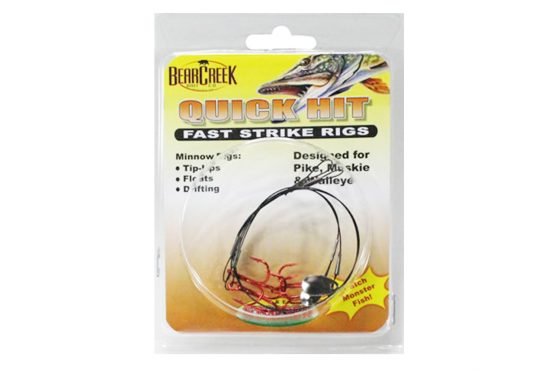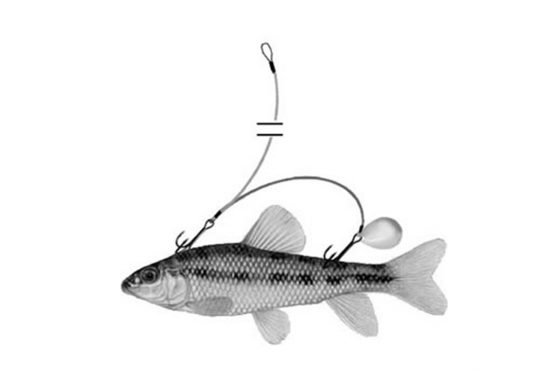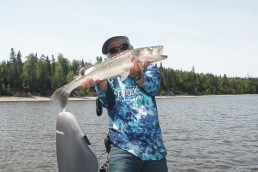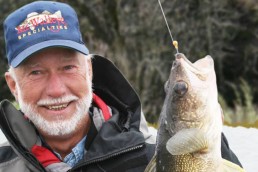Hard-Water and Open-Water Rigs for Pike and Walleyes
SHARE THIS POST
I like lures and techniques that can be used throughout the year. Quick-strike rigs have been around for years, but they are not understood and not used nearly as much as they should be. A quick-strike rig is simply a rig that has two treble hooks tied onto a leader, which are adjustable in position to fit the size of your bait.

One of the best rigs available is the Quick Hit Rig from Stopper Lures. We use this rig during winter, at ice-out lasting maybe into late May, once again in late fall. It is equally effective on pike, walleyes and yes, bass. Down south, many anglers target bass on huge shiner minnows, and a scaled-down version works equally well.

The beauty of this rig is, rarely will you get a gut-hooked fish. My records show a 95% success rate on mouth-hooked fish. When a fish trips your flag, pulls down your float or hits a dead bait laying on the bottom, you simply pick up any slack until you feel the weight of the fish, and then you strike with your hand (ice fishing) or rod (open water). There’ no need to let the fish run.
The best locations are where baitfish are found. The top of a flat with vegetation, or new young growth in the spring. Vegetation encourages game fish to search for an easy meal. Cold-water fish like an easy meal.
Therefore, one bait should be placed on the bottom. Remember this can be via a Bear Creek tip-up or under a Carlisle slip float during the open water season. Pike love dead bait and are scavengers.
A second tip-up or rod should present a suspended bait. I like having the second bait a foot higher than the bottom, either atop a shallow flat, or at the same depth of the bottom of the flat, but placed along the edge of the first drop-off. With three tip-ups or three slip floats, anglers can cover the actual flat, the edge of the breakline and the base of the drop-off bordering the flat.
Dead smelt are my go-to bait during the winter and the first two weeks of ice-out pike fishing. We also try to carry lively creek cubs or something similar on each outing. Mix it up between the two, definitely with a dead smelt on the bottom.
Dead smelt are oily and throw off a scent trail. You really need to go online, find whole frozen smelt and try them for pike—a true killer bait. The best lively minnows mimic what you have naturally in your lake. This might require trapping a few.
Walleyes show a preference for a lively minnow. During winter and late fall, a big creek chub is tough to beat. If you run into a school of small perch, save a dozen to be used on the gamefish. Many times, we will set up two tip-ups or throw out 2 slip floats, and fish for perch with another rod.
We find fewer suspended walleye in winter compared to summer. The exception comes when fishing the edge of the first drop-off and the deep water adjacent to the outer flats. Late-fall walleyes can be nose-to-the-bottom in places like Hardy Pond, and found suspended 25 or 30 feet deep on lakes like Muskegon.
Are you enjoying this post?
You can be among the first to get the latest info on where to go, what to use and how to use it!
Fishing bottom or near bottom for walleyes is best suited in open water during late fall and winter. Keep one bait 4 inches from the bottom and another bait maybe 1 to 2 feet up from the bottom. Watching your graph often provided clues to their exact location.
In early spring, walleyes are suckers on new weed growth. If your lake has cabbage weeds, keep track of the weeds. The easiest fishing is from new growth and continuing until the weeds reach halfway to the surface. You can fish these fish at the base of the weeds, and over the tops of the weeds with a slip float.
New weed growth in the spring brings a combination of species. Walleyes and pike are the primary targets, but plenty of bass will hit the minnows. Another reason for the quick-strike rig; no wounded or hurt fish.
If you have a pond, a cheap way to keep minnows alive at home involves purchasing a plastic barrel. Drill a bunch of holes in the barrel and place it into the pond. No pond? Then buy an inexpensive aerator and drop that into the barrel (no holes!). Keep your barrel is in the corner of the garage. Change out the water occasionally, and throw in crackers to keep your bait healthy.
I generally use an egg sinker slid onto the line, and then a swivel bearing is tied on. Then tie on the Quick Hit Rig. Your barrel swivel will stop the egg sinker from dropping down to the hooks.
If using a float, make sure that it is a Carlisle slip float. A slip float is adjustable for both suspended and deep-water fish. Use enough weight to keep your float upright, but with part of the float just starting to sink. You want just over half of the float submerged. Ice anglers, use just enough weight to keep your line vertical and tight.
For bottom-hugging fish in spring we use the old fashioned 3-way or Wolf River rig as some would call it. I love a 3-way rig. You can walk it up and down a steep breakline. When we feel a hit, we drop the rod tip back toward the fish, letting the rig collapse. Then we reel in slowly until we feel some weight, and set the hook. This is a great way to fish for pike and walleyes in spring.
Our favorite bodies of water have some of the following: A large marsh for spawning, deep water, good weeds and good forage. Connecting bodies of water to the Great Lakes are hands-down the best.
Muskegon Lake, Lake Mac, the Grand River system, the Kalamazoo River system, Manistee Lake and White Lake on the west side are prominent waters that we fish. Portage Lake that connects to Lake Superior is another of our favorites.
Inland lakes that we fish with good success include Hamlin Lake, Houghton Lake, Gun Lake, Lake Cadillac and Lake Mitchell. We lean toward larger inland lakes with a good mixture of shallow water and deep water.
Anglers fishing on the east side should find success on their connecting waters as well. Talking with the local DNR will point you in the proper direction.
Quick Hit Rigs are awesome and have a well-deserved spot in my box. We started using this type of rig 30-plus years ago. Find out what you are missing; it’s a great way to fish for gamefish with the family.
MWO
SHARE THIS POST
Did you enjoy this post?
You can be among the first to get the latest info on where to go, what to use and how to use it!
Jack Payne
Jack Payne is an accomplished angler and hunter who enjoys teaching others as much as learning from others. Seminar speaker, outdoor photography enthusiast, hunter safety instructor and volunteer at many events for both kids and adults as an instructor.



